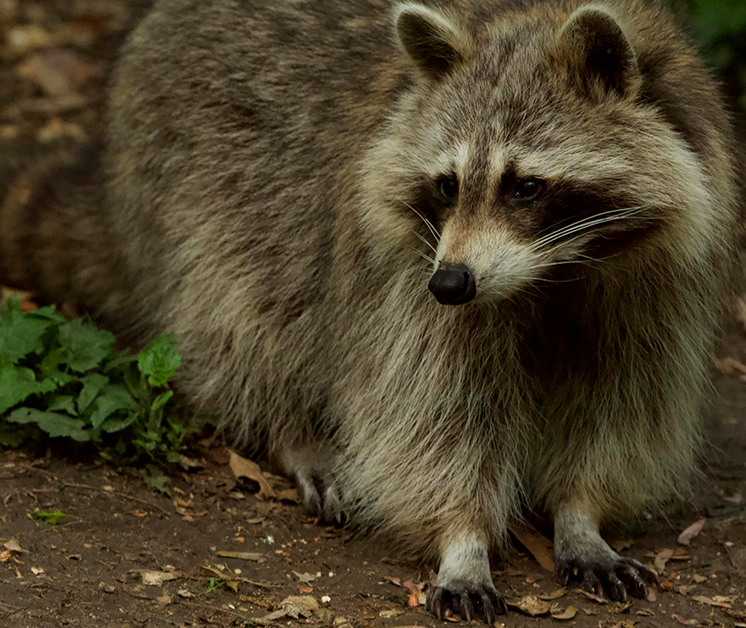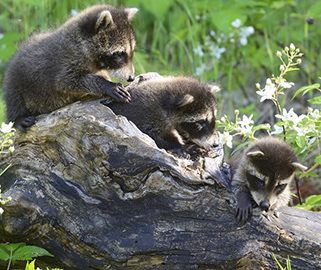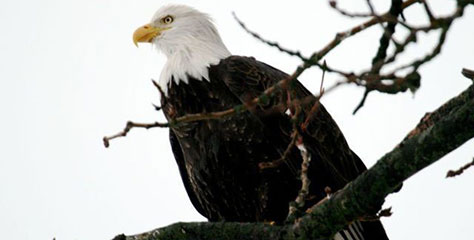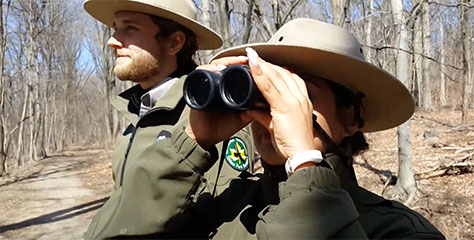Meet the Masked Mammals of the Concrete Jungle
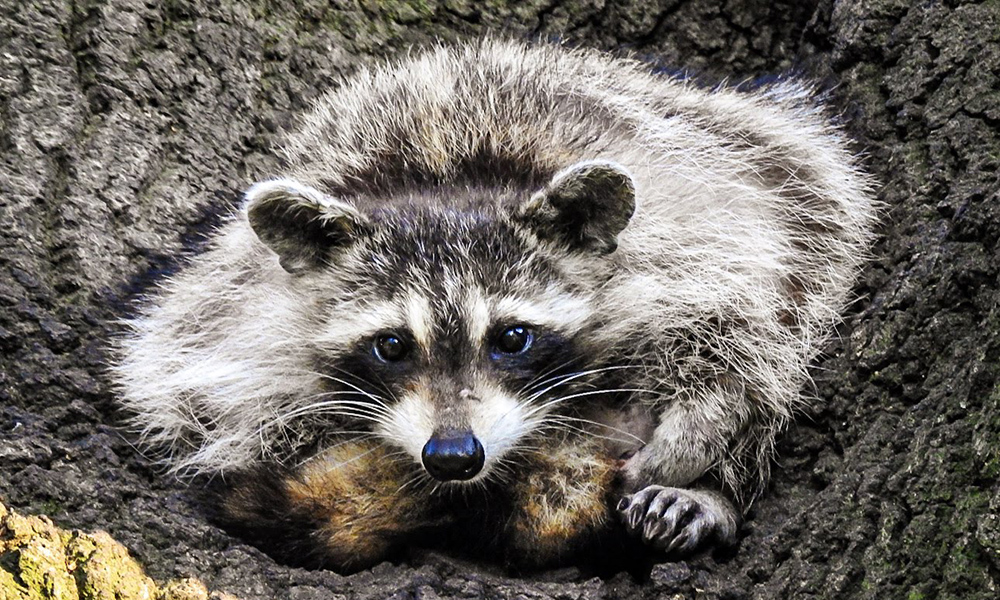
Raccoons are true New Yorkers in every sense. They look good in black, they’re primarily nocturnal, and know all the best spots to grab a meal. Intelligent and adaptive, raccoons are able to survive in a variety of habitats from rural to urban settings. By discovering a little more about their biology, history, and taxonomy, we can better understand how important raccoons are to our ecosystem, and how best to live alongside them!
* Click on image to view larger
Appearance
The raccoon is a medium-sized mammal, typically 28 - 41 inches long, including its tail, which can be up to ten inches! These tails have between 5 and 10 dark rings, matching the dark fur around their eyes. This eye mask may enhance their reputation as troublemakers, but it actually serves an important function: the dark fur helps reduce glare from bright lights and improves their night vision! The rest of their fur is a combination of gray and brown, providing camouflage and keeping them warm in the winter.
Baby raccoons, called “kits”, are born with very light pelts, and their masks and tail rings darken as they age.
Diet
Raccoons are classified as omnivores. They can eat both meat and plants and they are the ultimate opportunists! Raccoons will eat just about anything, from mice, grubs, and crayfish, to mushrooms, fruits, acorns, and walnuts, to pet food and even human food waste. For a wild raccoon, a large portion of their diet comes from invertebrates and a healthy environment with clean soils can provide a raccoon a lifetime of grubs, berries, frogs, and crayfish. As with all of our wildlife, they don’t need our help to eat. Never feed wildlife! Securing, composting, and properly disposing of garbage are all key to preventing raccoons from becoming dependent on human trash.
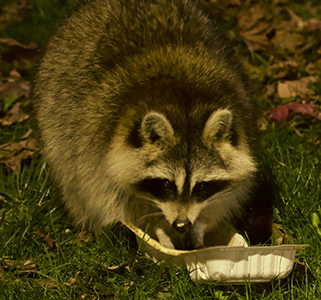
Behavior
Raccoons have some of the most sensitive hands in the animal kingdom. Their scientific name, Procyon lotor, comes from the Latin word of “washer”. Their colloquial name, raccoon, derives from the Algonquian term arahkunem, meaning one that rubs with its hands. Raccoons are often seen rubbing their food, and even “dousing” it in streams or ponds. Water helps soften the tough skin on a raccoon’s palms, allowing it to better feel whatever it’s about to eat.
While you’re most likely to spot one descending a tree at night in the park, raccoons can forage for food at all times of day and in all seasons and weather. After rain or a snowstorm, see if you can spot their five fingered tracks in wet earth or snow. You may even find some tracks in freshly poured concrete!
* Click on images to view larger
Habitat
Raccoons can be found in all five boroughs of New York.
Raccoons are primarily cavity dwellers, particularly when raising a family. Only forests with older, larger trees can provide the structures raccoons need to live, breed, and thrive, such as tree cavities! Cavities in trees form when a tree is injured or damaged but the trunk has time to heal and harden. New York City is home to many old trees, with a few that even predate European colonization. Having parks with suitable homes for raccoons keeps them in natural areas–but if raccoons can’t find the real estate they’re looking for, they’ll move in wherever is convenient. This can be inside of walls, unsecured trash bins, or even under the hood of a vehicle.
Raccoons sometimes need to move their young family between dens. Because of their size, raccoons can’t move all of their babies at once. If you see a lone baby raccoon, the mother is likely nearby and coming back for them! If they are in distress (i.e. visibly injured, surrounded by insects), call 311 to refer the issue to the Urban Park Rangers.
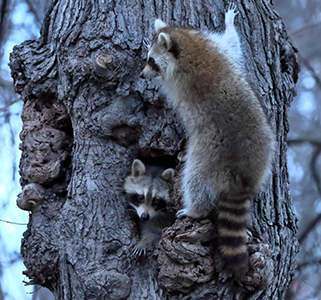
Observe and Explore the Life of Urban Raccoons
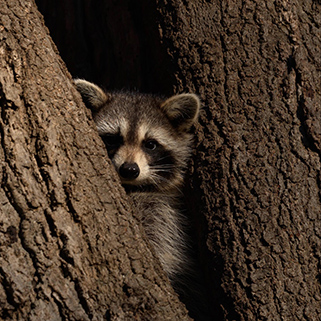
- Pack out your trash: When you visit our parks, take only pictures and leave only footprints! The less trash that stays in the park, the fewer dumpster-diving raccoons we will have!
- Keep your distance: The New York Department of Environmental Conservation, the New York City Department of Health and Mental Health, and NYC Parks work together to closely monitor the spread of disease in our raccoon communities. Raccoons carry many diseases that can spread to humans and pets, including fatal pathogens like rabies and distemper. If you are ever approached by a raccoon, make sure to “haze” the animal with loud noises, arms held high, and by stomping your feet–this will help discourage them from approaching other park visitors, keeping them safe!
- Day or night, know where to go: Raccoons prefer areas where they can sleep in peace, and that means having a good place to hide. Forested areas in Central Park, Van Cortlandt Park, Alley Pond Park, Blue Heron Park and Prospect Park all provide the ideal habitat for raccoons. Although they are most active at night, healthy raccoons can be seen at any time of day. For instance, females will be more active during the early spring as they forage to be able to feed their young.
- Keep dogs leashed, especially in natural areas: Raccoons will avoid interactions with dogs whenever possible, but even healthy raccoons will fight back if chased and cornered!
- Car, e-bike, or scooter: go slow! Raccoons often travel at night, all too frequently becoming roadkill. If you’re driving or riding through or near a natural area, be mindful of your wild neighbors, and watch your speed!
- If you see an injured or sick raccoon: Raccoons that appear dizzy and stumbling, or that don’t move away when humans get close may be in trouble. If you spot a raccoon behaving this way, with cloudy or crusty eyes, or foaming at the mouth, call 311! Our non-emergency city services number can contact the Urban Park Rangers, who will investigate and determine what steps are needed to help the animal.
Explore Wildlife in New York City
New York City is home to an amazing abundance of wildlife from birds to eels and coyotes and deer. Learn more about their life here in the big city and how we help them thrive.
Wildlife in New York City
Discover which wildlife live in our city and find fun wildlife activities to learn more!
Wildlife Calendar
Use our wildlife calendar to learn about wildlife behavior by the month and where they thrive in our city.
Wildlife Programs
Join our Urban Park Rangers and friends as we head into the park to see and learn about wildlife.

